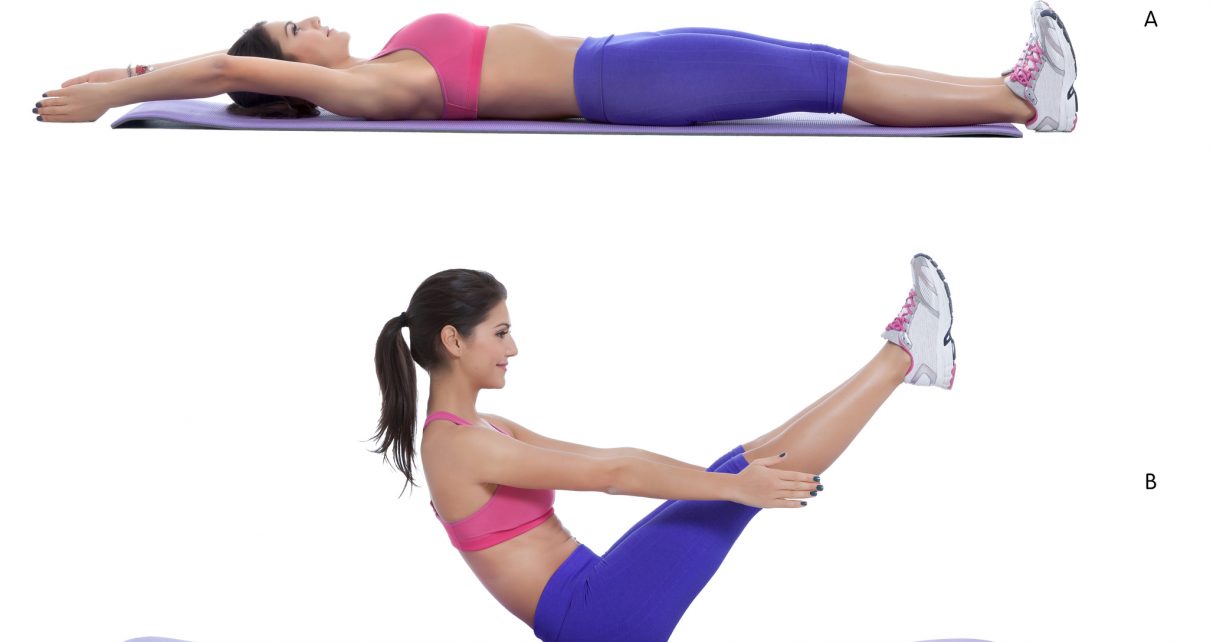Most people would love to have abs that are sharp enough to open a can of tuna, yet many trainers put their ab training on the back burner during this time of year. That’s too bad, because abdominal training doesn’t have to consist of complicated exercises on chrome machines. Although many machines are effective, simpler exercises can be just as effective. Fall and winter is the ideal time to really target your abdominal training so by the time beach weather hits, you’ll be hosting razor-sharp abdominals, provided your diet is clean. V sit-ups is an exercise that needs no fancy equipment, but it will activate the entire anterior abdominal wall and the lower and posterior abdominal muscles. V sit-ups can be an important part of kick-starting your abdominal program.
Overview of Muscle Structure and Function
The central muscle in the anterior abdominal wall is the rectus abdominis. This muscle is partitioned vertically in the middle by a tendon that’s about one-half to an inch wide, called the linea alba. This tendon stretches from the xiphoid process at the base of the sternum to the pubic bone of the pelvis. The rectus abdominis has a taper to it, so it’s three times as wide at the top (superiorly) as it is at the bottom (inferiorly). As a result, the upper portion of this muscle is stronger than the lower sections. The rectus abdominis is anchored centrally on the pubic bones of the pelvis and superiorly on the xiphoid process. Although there’s some genetic variability, usually there are three rows or blocks of tissue at the level of the xiphoid process below the sternum, the umbilicus (“belly button”) and about halfway between these two structures. When the rectus abdominis is tensed, the short fibers bulge between the tendinous grooves, giving the “six-pack” look.
Contracting only one side of the rectus abdominis (e.g., the right side) flexes the torso toward the same side that’s contracting (e.g., the right side). However, if both right and left halves of this muscle contract, the head and chest move closer to the hips and legs.
The external oblique is a large and superficial muscle. It begins on the fifth through twelfth ribs by small bundles of muscle fibers and ends on the linea alba and pubic and iliac bones of the pelvis. These bundles of fibers are intermingled with the serratus anterior muscle and the latissimus dorsi muscle. If your body fat is low enough, these digitations (particularly external oblique and serratus muscles) will give the impression that a large animal has left its claw marks across your side. When both left and right sides of the external oblique muscles work together, they flex the trunk so the head moves toward the feet. If only one side contracts, the trunk flexes toward the opposite side.
The internal oblique muscle lies just deep to the external oblique muscle. It begins on a thick connective tissue sheath located in the lower back, called the thoracolumbar fascia and also from the iliac bone of the hip. Its fibers fan out and run toward the head to attach on the lowest three or four ribs. In contrast to the external oblique, the internal oblique will twist the body toward the same side (i.e., toward the right if only the right side contracts). However, similar to the external oblique muscle, the internal oblique will flex the trunk at the waist and move the head toward the feet, if both left and right portions contract together.
The iliopsoas muscle is the most powerful flexor of the thigh at the hip joint and it’s strongly activated during the leg raise part of V sit-ups. The iliopsoas is a combination of iliacus and psoas muscles. The psoas major attaches along the sides of the lumbar vertebrae and the intervertebral discs in this region (the discs between each of the vertebrae) and it descends to the pelvis to attach to a small bump on the femur bone of the thigh called the lesser trochanter. The iliacus is a triangular muscle that lies along the inside of the iliac bone of the hip. Its fibers run inferiorly (toward the feet) and medially (toward the midline of the body) and attaches to the tendon of the psoas muscle. The iliopsoas bends the lumbar region anteriorly (forward flexion) such as when sitting up from a supine position or if you’re raising your legs up toward your torso.
V Sit-ups
This exercise is a combination of a partial sit-up (like a modified crunch) and leg raises. It activates your anterior and lateral abdominal wall (rectus abdominis, internal oblique and external oblique muscles) and the leg raise part activates the lower part of the rectus abdominis and the iliopsoas.
1. Lie on the floor with your legs straight and your arms over your head.
2. Raise your upper back from the floor and at the same time begin to lift both legs from the floor.
3. Continue to lift your upper body and your legs with the object of trying to touch your fingers to your toes so your thighs come as close to your torso as possible. The top position of the exercise will form a “V” position between your torso and your legs.
4. Hold this “V” for a count of one (you can work up to a count of two over a few weeks) and then return to the floor.
5. Without pausing on the floor continue into the next repetition. Try to begin with 20 reps on each set for three to four sets. Work up to at least 50 reps.
The idea isn’t to throw your arms up to meet your feet. If you’re using momentum and not abdominal effort, you’ll be wasting your time. You must do the exercise in a pendulum motion that’s continuous, but controlled. You should feel your abs cramping with each repetition if you’re doing it correctly. To increase the effectiveness of the movement, try to isometrically squeeze the abdomen when you’re in the V position at the top. This will add to the fire that should be burning across your rectus fibers and help to etch in the grooves between each block of rectus abdominis. If you would like to increase the work to the internal and the external oblique muscles, try twisting as you come up, so you touch your hands to the right foot on one repetition and your left foot on the next repetition.
As a word of caution, if you have previously injured your lower back you may want to do a single leg raise V sit-up. In this version you’ll lift your upper body and both hands up to meet one foot while the other foot remains on the floor (with the knee bent). On the next set you would switch to the opposite leg. The one leg version is easier and less stressful to the lumbar discs, but if you still have lower back pain, discontinue the exercise.
Holding your breath increases intra-abdominal pressure and prevents the abdominal fibers from shortening as much as they should. It’s good to either exhale as you’re coming up or even better, exhale before you do the contraction, then concentrate on achieving a maximal shortening of the fibers during the exercise.
Although it’s simple in one sense, it’s a rather tough exercise to do correctly. Often people will raise their legs before the torso or sometimes the reverse, but you must raise them at the same time. Once you get it down, you’ll begin to feel your entire abdominal wall go into a serious meltdown. Nevertheless, V sit-ups alone won’t fix a weak waist if you have a sloppy high-fat and calorie-excessive diet. In addition to tightening your diet, you should begin with 20 minutes of cardio three times a week to reduce your body fat. You don’t have to go crazy with the cardio workouts, because there’s still time before summer hits, but you do need to get it rolling now. With your improved diet and ramped-up cardio, V sit-ups will add an important dimension to getting your abs in better shape than you’ve every had. While great abdominals don’t evolve overnight, if you carefully set high standards and realistic goals and deadlines to achieve these successes, then nothing should stop you from meeting those goals. The payoff is your abdominals can turn from a rounded, soft pillow into razor-sharp, diamond-cutter-hard muscle bundles.
References:
1. Avedisian L, Kowalsky DS, Albro RC, Goldner D and Gill RC. Abdominal strengthening using the AbVice machine as measured by surface electromyographic activation levels. J Strength Cond Res, 19: 709-712, 2005.
2. Basmajian, J.V. and C.E. Slonecker. Grant’s Method of Anatomy. A Clinical Problem Solving Approach. 11th edition. William and Wilkins, Baltimore, 1989, pp.441-542.
3. Krause DA, Youdas JW, Hollman JH and Smith J. Abdominal muscle performance as measured by the double leg-lowering test. Arch Phys Med Rehabil, 86: 1345-1348, 2005.
4. Norris CM. Abdominal muscle training in sport. Br J Sports Med, 27: 19-27, 1993.
5. Soderberg GL and Cook TM. An electromyographic analysis of quadriceps femoris muscle setting and straight leg raising. Phys Ther, 63: 1434-1438, 1983.
6. Sternlicht E, Rugg SG, Bernstein MD and Armstrong SD. Electromyographical analysis and comparison of selected abdominal training devices with a traditional crunch. J Strength Cond Res, 19: 157-162, 2005.
7. Urquhart DM, Hodges PW, Allen TJ and Story IH. Abdominal muscle recruitment during a range of voluntary exercises. Man Ther, 10: 144-153, 2005.
The post Get Razor-Sharp Abs With V Sit-ups first appeared on FitnessRX for Women.





